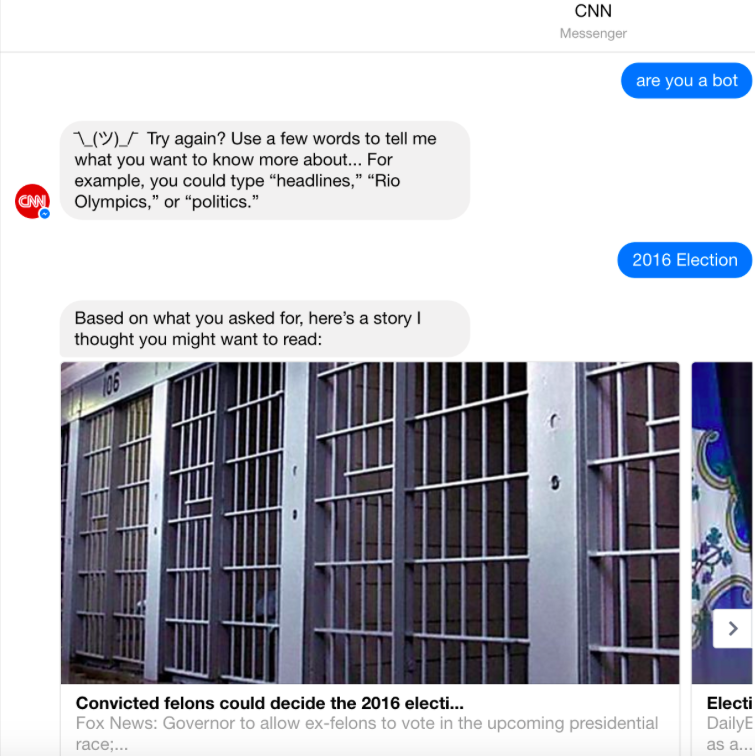With bots being the main focus of both Microsoft’s Build and Facebook’s F8 conferences, the entire software industry seems to be touting this technology as the end-all, be-all solution for the issues facing mobile apps.
It’s always great to see strong enthusiasm surrounding a technology, but it’s important not to get ahead of ourselves.
The current wisdom is that it’s difficult for brands to convince users to download their apps — or even remember to use them — but if users can just tell a machine what it wants and have a bot search for it, this ease of use would be revolutionary.
Unfortunately, the reality of bots hardly seems like the pinnacle of technological innovation. This is what today’s bots really look like:
Today’s bots are promoted as AI-driven, but they have limited response ranges. When used in real-world applications, these limitations can be pretty easy to find. In the end, the rigidity of bots makes them feel less human, leaving users with the burden of overcoming a learning curve that the computer should be able to cover by itself.
When Graphics Replaced Text
Programmers had the same dream when the graphical user interface (GUI) replaced the command line. Instead of needing to enter rigid, text-based commands into a command line, people were able to see what functionality was available and select what they needed.
The success of GUIs made computer technology truly approachable to the mass market for the first time. By visually establishing the limitations and capabilities of an application, an entire generation was able to use machines to accomplish everyday tasks.
It’s not that a GUI is more open than a command line — they both can accomplish the same tasks. GUIs simply make it easier for a person to understand and visualize their options without needing to memorize a lengthy set of rules.
Today’s bots are more like a throwback to the days of command lines than the next evolution of the GUI.
Challenges of Bot Applications
For bots to achieve mainstream success, they need to resolve the same issues that GUIs solved for command lines. Simple actions like ordering a pizza, reserving a table, or booking a flight are great use cases for bots, but people don’t typically download an app just to complete these tasks.
Because of this, a truly useful bot needs to be able to do one of the following:
- Focus on user expectations. Although Facebook Messenger is branded as a conversational interface, it’s doing so by adding components that actually make it feel more like a GUI.
Back in March 2015, the company introduced a payment option into its messaging platform. A typical bot might simply provide a rigid command line with options like:
- Send Money
- Receive Money
- Check for Money
- See Balance
- Return to Conversation
Such a system is difficult to use and hardly feels natural.
Instead of the typical bot approach, Facebook Messenger’s bot simply hyperlinks, sliding views and clickable buttons that make it easier to select the options you’d like from a list of many. This allows users to send and receive money (or choose not to) without interrupting the normal conversational flow.
If a user clicks the hyperlink, they select option A, which, once completed, would prompt the recipient for option B. The bot doesn’t have any misunderstandings because the context of the conversation doesn’t matter. People can make the decision using visual cues.
- Support full human conversation. These chatbots are not really AI (in theory or in practice). They’re equivalent to a sophisticated Mad Lib, determining what a user wants when given very specific (and structurally predictable) commands. It understands “Order me a cheese pizza and a pepperoni pizza,” but it has trouble with something even a little more abstract: “Order me two pizzas — one cheese and one pepperoni.”
Bot advocates boast the ease of development as a huge advantage of bots, but to go beyond the limited command structures supported out of the box is a “Manhattan project” of sorts — it requires a small army of data scientists to hit most use cases, typically just in one domain, such as scheduling meetings or ordering food.
We take it for granted, but the capability of the human brain to understand the context of a conversation is astounding. In fact, normal conversation is so advanced, it’s considered an AI-complete problem. If a computer could be designed to participate in a human conversation like another human, AI has likely been created along with it. We call this the Turing Test. Until then, your users will have to learn how to stay within the boundaries of what your bot expects.
Once true AI is created, it’s no longer necessary for brands to build bots or apps. You could just ask your AI for whatever you need, and it’ll scour every bot, app, and website until it accomplishes this for you.
Bots may be able to perform extraordinary services, but they’re always going to need humans to provide common sense. No matter how many options are programmed and accessible to a computer, regional and generational language differences alone are enough to make understanding context difficult for a machine.
In that way, bots fall in a strange middle ground — an oasis between two extremes (entirely user driven GUIs and entirely automated AIs). To see bots as a final destination is folly.
The Reality of Bots
In reality, bots are nothing more than a turning point in a new direction of UX design. Conversational interfaces are improving by leaps and bounds, but they’re no closer to replacing traditional apps today than they were 20 years ago.
The optimism of bots is based more on science fiction than the reality of where bots actually are today.
Most applications we use are games, entertainment, social networking, banking, and the like. These applications require a graphical interface, and are unlikely to turn into bots anytime soon. It’s unlikely that a chat bot will ever replace business applications like PowerPoint, Excel, or SQL Quickbooks, either — some tasks are better done visually.
There’s a reason GUIs replaced text command lines, and until conversational interfaces become capable of holding true conversations, chatbots are going to feel more limiting than liberating.
More articles About Bots
Humans, AI, and User Interface
Why Customer Service should include Chat Bot
Photo Courtesy Shutterstock Mobile Phone with Robot








